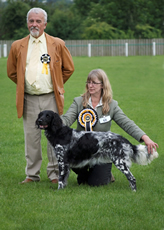Large Munsterlander
|
Photo with thanks to Christine Weber, www.largemunsterlander.org.uk |
Large Munsterlander
Breeders & Puppies For Sale If your
a Large Munsterlander breeder and have Large Munsterlander puppies for sale, send us your details for free and we will add to our Large Munsterlander Breeders page.
Large Munsterlander
Rescue Center Visit the Large Munsterlander rescue centers if your looking to rescue a Large Munsterlander, as well as learn more about the breed or just support the rescue centers for there hard work.
Group Gundogs (KC)
Origin /
History The Large Münsterländer, also called the Grosser Münsterländer, is one of several breeds of gun dog bred for sport in Europe in the early 20th century. It was recognized by England’s Kennel Club in 1919 and established its breed standards only in 1921, making it a fairly young breed. Before its official recognition, it was classified as a variant of the German Longhaired Pointer.
The breed is named after the German region of Münster, where it was originally developed as a bird dog. Although not the most popular of the gun dogs, it is highly valued even outside of Germany for its ability to point, track, retrieve, and work in any weather and terrain—the very skills that make up an all-purpose hunting companion.
Appearance The Large Münsterländer is muscular but not bulky, with a long coat and high, elegant stature. Apart from its color, the breed is characterized by its broad ears, which are feathered and drop close to the head. The legs and tail are also feathered, but the angle of the feet should be visible. Males tend to be more feathered than females.
Colours The coat should be black-and-white, although brown coats occasionally occur. White snips or stars on the head are allowed, as solid black coats are not considered desirable.
Temperament This is a highly intelligent and obedient breed, making it an ideal house pet. They are usually very friendly, but may get too attached to their human companions—if they like you, they won’t leave you alone for a minute! They also don’t like being alone—they tend to get destructive and bark loudly when left on their own. Most owners keep them in indoor kennels when they have to leave, but leaving them there all day is not recommended. If you spend long hours away from home, this may not be the breed for you.
Height and
Weight The acceptable height is 23 ½ to 25 inches for males and 23 to 25 for females. Males can weigh between 25 and 29 kg; females should be approximately 25 kg.
Common Health
Problems The Large Münsterländer is a fairly healthy breed, but hip dysplasia is common in some lines. There are no hereditary problems to watch out for. Most problems are seasonal: the dog may feel hot in the summer because of its long coat, and ticks and fleas may occur in some areas.
Living Conditions Although they’re fairly active indoors, Large Münsterländers largely prefer the outdoors and are not suited for apartment life. These dogs thrive best in homes with large yards where they can run around and play for hours. When indoors, they either sleep or find things to play with; they are seldom idle. Owners should always have a bone or some other toy to keep them occupied, otherwise they will get at furniture, carpets, and anything else within reach.
Exercise
Requirements Like any hunting dog, the Large Münsterländer need regular exercise to stay healthy and active. They should be taken on a daily jog or brisk walk and played with regularly. Keep them on a leash when walking, as they will crawl under every bush or car in search of small game. Active play is recommended, although they tend to tire after 20 to 30 minutes.
Training Requirements The Münster takes extremely well to obedience training and can be house-trained as early as six months of age. However, they thrive best as working dogs, so it’s best to teach them a few basic household tasks (such as picking up shoes and toys). Take care not to “over-train” them in the field, though, since they may start attacking birds, squirrels, and other small animals.
Life Expectancy This breed can be expected to live 12 to 13 years.
Grooming Grooming needs depend on the length of the coat. Bitches have shorter coats and will do with brushing every three to four days, but males have to be brushed every two days. This breed sheds heavily once or twice a year, most often in the spring. Regular brushing will help minimize the shedding.
Famous Examples
CompleteDogsGuide Comment
Breeders
Comments: Send us yours comments, advice for owners, potential owners etc.
Owners Comments: Send us any of your comments. Thanks in advance.
More Large Munsterlander Information: Check out our Large Munsterlander Clubs and links to more informative websites dedicated to the breed.
Submit your Large Munsterlander pictures Send us any pics of your Large Munsterlander, let us know there name and age and any other details. We'll add to this page. Contact us
| Large Munsterlander Photos |

Flikka |
|
Photos with thanks to Pat McCutcheon, www.ichbinandfluich.co.uk. |
|